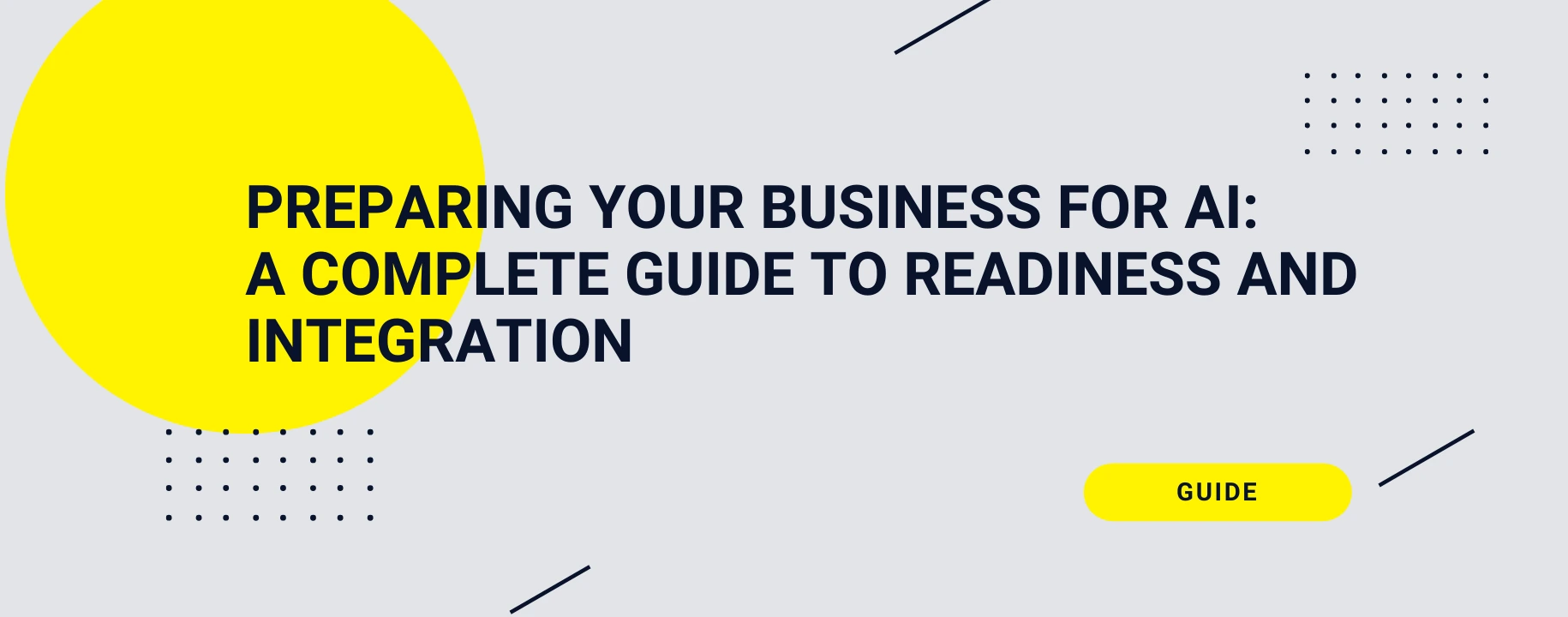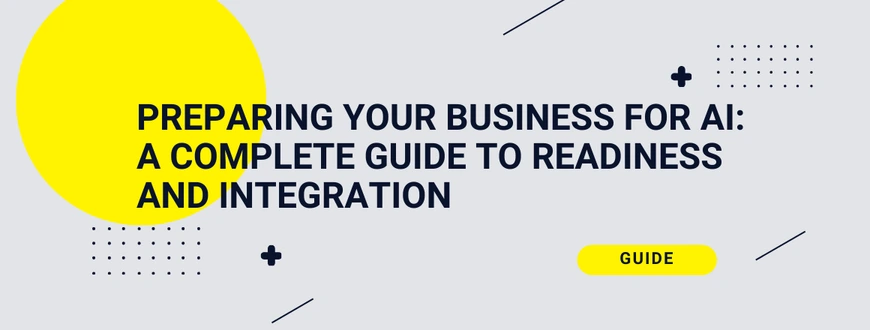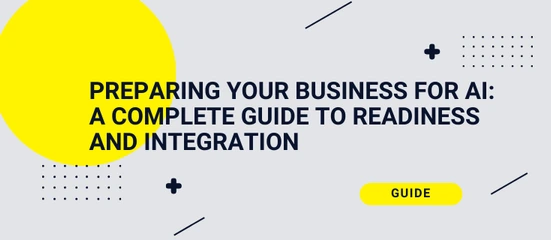- Product development
- 14 Nov 2024
Is Your Business Ready for AI? A Guide to AI Readiness Assessment and Integration
Being AI ready means that your organization has the foundation to leverage AI solutions.



Table of contents
Contributors

Blog Summary
- Evaluating AI Readiness: Assessing AI readiness is essential to ensure that organizations can adopt AI technologies effectively. It involves reviewing critical aspects like technology infrastructure, data quality, and workforce preparedness.
- Maximizing AI Benefits with Proper Planning: A thorough AI readiness assessment minimizes risks and maximizes the benefits of AI, such as improved operational efficiency, strategic alignment, and a competitive advantage in the market.
- AI Readiness in Action – A Case Study: A real-world case study highlights how AI-powered contouring in radiotherapy reduced treatment time by 90%, showcasing the importance of AI readiness in achieving transformative results.
What is AI Readiness assessment?
AI Readiness Assessment is a structured process used to evaluate how prepared an organization is for AI adoption and AI integration. This assessment identifies the strengths and gaps in critical areas such as technology infrastructure, data quality, and workforce capabilities, which are essential for successful artificial intelligence integration. Being AI ready means that your organization has the foundation to leverage AI solutions effectively and align them with business objectives.
The AI readiness assessment typically covers several key factors, such as:
- Technology Infrastructure: Determines if your systems can support AI solutions, a critical step in achieving enterprise AI adoption.
- Data Readiness: Ensures that the organization has the necessary data quality and accessibility, which is fundamental to AI.
- Workforce Skills: Assesses whether your employees have the skills to adopt AI, helping businesses be truly ready for AI.
- Strategic Alignment: Checks if your AI adoption aligns with your company’s long-term goals and if you have defined measurable objectives.
Why AI Readiness is Essential for Success
As businesses increasingly look to adopt artificial intelligence (AI), understanding AI readiness becomes critical for ensuring success. AI adoption can offer transformative benefits, but without a structured AI readiness assessment, companies risk significant disruptions to their operations. Assessing how AI integration will impact existing technology infrastructure and processes is key to avoiding these pitfalls. By taking the time to understand whether your organization is truly AI-ready, you can ensure a smooth and effective transition.
A structured AI readiness plan brings numerous benefits to an organization, including agility, scalability, and risk reduction. It enables businesses to respond quickly to changes, scale their AI solutions as needed, and minimize risks associated with premature or ill-planned AI implementations. Such an approach ensures that AI is aligned with business objectives and that the company’s data readiness, workforce skills, and systems are capable of supporting artificial intelligence integration.
Moreover, being ready for AI gives companies a significant competitive advantage. A well-prepared business can leverage AI to streamline operations, reduce costs, and enhance decision-making, positioning itself ahead of competitors who struggle with AI adoption. Utilizing an AI readiness checklist and understanding the criteria for success in artificial intelligence ensures that companies not only adopt AI but also do so in a way that maximizes its potential for long-term success. AI readiness is more than a checklist—it’s a strategy that provides a clear path to effective, scalable AI solutions that can propel businesses forward in a competitive marketplace.
Steps to Assess AI Readiness
- Assess Current Technology Infrastructure
Assess the current technology infrastructure on board, including data systems, cloud capabilities, and the overall technology stack. This is necessary to ensure that the current setup can support AI adoption and what upgrades are required to facilitate artificial intelligence integration. Having robust infrastructure is one of the key components of being AI-ready.
- Assess the Quality and Availability of Data
Again, success in adopting AI depends much on the quality of the information. Ensure your organization has clean and structured data which, in turn, will be available for processing by AI systems. Standardize the process to prepare and make your data AI-ready, ensuring it meets enterprise requirements for AI adoption.
- Assess Organizational Culture and Skillsets
This means your workforce is prepared to embrace the integration of AI. Identify the prevailing skill sets and identify the areas where upskilling or training is required. An AI-enabled culture will ignite a passion for embracing the latest innovations in this way. Let your teams be enabled to deal with the adoption of AI through industry-specific utilities and technologies.
- Evaluate Use Cases and AI Objectives
Precise identification of the AI use case and definition of a measurable objective are elementary in aligning each AI project with your strategic business goals. Clearly identify how AI will drive success for your company by solving a challenge or seizing an opportunity. You’ll be able to ensure value delivery through AI adoption.
- Build the AI Adoption Roadmap
Plan a strategy for AI implementation, describing in detail the steps taken to integrate AI into your operation. Take the time to align stakeholders and ensure decision-makers’ buy-in to ensure ongoing project execution. This is your roadmap to minimize risks and maximize benefits from AI adoption within your organization.
Exploring Global AI Readiness: 2023 Trends and Key Insights
The 2023 Government AI Readiness Index offers a detailed assessment of how prepared governments across the world are to integrate artificial intelligence (AI) into public services. The report highlights several key themes related to AI adoption, AI integration, and AI readiness assessment. Here’s a breakdown of the analysis based on the document:
AI Adoption and AI Readiness
The Government AI Readiness Index evaluates how governments globally are increasingly focusing on AI adoption as part of their broader digital transformation strategies. The index ranks countries based on their readiness to leverage AI, using 39 indicators across 10 dimensions, grouped into three main pillars:
- Government
- Technology Sector
- Data & Infrastructure
This structure allows the index to assess how prepared a government is for AI adoption and integration in public services. AI-ready countries typically demonstrate strong internal digital capacity, technical skills, and governance structures that are adaptable to new technologies. As governments progress toward adopting artificial intelligence, a robust foundation of data availability, regulatory policies, and ethical considerations is essential.
AI Integration
The report emphasizes the role of AI integration, noting that high-income countries are generally leading this process. Countries like the United States, Republic of Korea, and the United Kingdom have successfully integrated AI within their government services, particularly in areas such as healthcare, digital identity systems, and infrastructure. This integration is supported by strong technology sectors that provide innovation and tools for government use.
In developing nations, AI integration is often facilitated through international partnerships. For example, Rwanda and Senegal have developed AI strategies with the help of global organizations, establishing a foundation for future integration of AI into public services.
AI Readiness and Assessment
The AI readiness assessment methodology highlighted in the report looks at essential elements like data infrastructure, human capital, governance, and regulatory frameworks. The Government AI Readiness Index assigns scores to countries based on these factors, offering a clear benchmark for their AI preparedness.
Countries like Singapore, United States, and United Kingdom rank highly in terms of AI readiness because of their comprehensive AI strategies, advanced digital infrastructure, and policies that foster innovation. Conversely, many lower-income nations face challenges due to gaps in digital infrastructure and data representation.
Global and Regional Insights on AI Adoption
- AI adoption by country varies, with high-income nations traditionally leading the way in publishing AI strategies. However, lower and middle-income countries, such as Rwanda and Senegal, are quickly catching up by releasing national AI strategies. There is a noticeable increase in participation from previously underrepresented regions, such as Sub-Saharan Africa and South and Central Asia.
- Countries developing their AI readiness checklist often include a strategic vision, robust digital infrastructure, appropriate governance, human capital investment, and ethical guidelines. Nations like Japan and China have established specific laws and frameworks to address the rise of generative AI, showing a proactive approach to AI readiness.
Criteria for Success in Artificial Intelligence
The criteria for success in artificial intelligence adoption outlined in the report include:
- Data quality and availability: AI systems require access to large, high-quality, and representative datasets.
- Infrastructure: Countries with well-developed digital infrastructures, such as Singapore and the Republic of Korea, are at the forefront of AI integration.
- Human capital: Nations investing in AI-related education and skills development, like Malaysia and India, are positioning themselves as key players in AI.
- Governance and ethics: Ethical frameworks, such as those introduced by Saudi Arabia and Egypt, are crucial for responsible AI adoption and implementation.
AI Readiness in Healthcare: Accelerating Cancer Treatment with Automated Contouring
Cancer remains one of the leading causes of death worldwide, with radiotherapy being a critical part of treatment for nearly 50% of cancer patients. However, one of the most time-consuming aspects of radiotherapy is the manual contouring of organs at risk (OARs). This process, essential to ensure that radiation doses are accurately targeted, can take hours, is prone to human error, and adds significant delays to treatment.
These inefficiencies are exacerbated by the shortage of radiotherapy specialists, which not only delays the start of treatment but also reduces the amount of time doctors can spend interacting with patients, affecting patient care quality and their overall treatment experience.
Solution: AI-Powered Contouring
The solution was an AI-based software developed to automate the organ contouring process using advanced algorithms to analyze CT and MRI scans. This innovation dramatically streamlined the contouring and image registration processes, reducing the time from hours to mere minutes.
Key Features:
- Detection of 31 Organs at Risk (OARs): The AI system accurately detects and contours critical organs, ensuring precise radiation dosage calculations.
- One-Click Automated Contouring: With a single click, the entire process is automated, enabling oncologists to significantly cut down the time spent on manual tasks.
- Hybrid Infrastructure: The solution operates on both local and cloud platforms and is fully GDPR-compliant, ensuring data security.
- User-Friendly Interface: Built on top of the OHIF viewer, the system provides an intuitive interface, making it easy for specialists to navigate the complex tasks of radiotherapy.
Implementation Approach
Close collaboration between AI engineers, oncologists, and radiology technicians ensured that the AI solution integrated smoothly into existing workflows. Training and support were crucial in overcoming the challenges posed by transitioning from manual to automated processes.
Technology Stack
- Frontend: React, Typescript, HTML, CSS, Material UI, RTK Toolkit, OHIF
- Backend & AI: Python, TensorFlow, PyTorch, Keras, FastAPI, PostgreSQL, Redis, RabbitMQ
- DevOps: AWS, Docker, GitLab CI/CD, Terraform
Results
- 90% Reduction in Contouring Time: The time for contouring OARs dropped from 3-4 hours to just 2 minutes, leading to faster treatment initiation.
- Cost Savings: Hospitals could save up to $200,000 annually by automating the contouring process, allowing resources to be redirected toward patient care.
- Enhanced Doctor Efficiency: With routine tasks automated, oncologists could focus more on complex cases and patient interaction, improving the quality of care.
- Improved Patient Experience: Patients benefited from quicker treatment starts and increased interaction with doctors, which improved their psychological and emotional well-being.
Key Learnings and Best Practices
The success of this project underscored the importance of close collaboration with medical professionals during development to ensure the technology aligned with real-world needs. Additionally, continuous feedback from oncologists allowed for iterative improvements, making the system more effective and user-friendly.
The project to accelerate cancer treatment through AI-powered contouring clearly connects to AI readiness assessment, evaluating whether an organization or system is prepared to effectively adopt and integrate AI solutions.
1. Data Availability and Quality
AI Readiness Factor: The availability of high-quality data is one of the most crucial aspects of AI readiness. Organizations need proper, relevant, and well-structured data to train and implement AI models.
Project Overview: The AI-automated contouring system needed millions of datasets of CT and MRI scans. The quality of medical images themselves, but more importantly, the correct labeling of organs, was very critical for the AI model to learn from and thus accurately detect and contour OARs. No robust, clean, well-annotated medical imaging data means no effective AI model operating.
2. Technical Infrastructure
AI Readiness Factor: Specifies fortunate technology infrastructure on cloud platforms, storage of data, processing capabilities, and AI frameworks for easy deployment of AI solutions.
The team developed Contouring in Project on a hybrid infrastructure supporting both local and cloud platforms. They integrated advanced tools like TensorFlow, PyTorch, Docker, and AWS into the system for scalable, flexible deployment, demonstrating high technological readiness. They ensured that the system could process large volumes of data in medical contexts securely and efficiently.
3. Organizational Buy-In and Stakeholder Engagement
AI Readiness Factor: Organizations should possess strong leadership buy-in and multi-disciplinary alignment across clinical, technical, and operational departments for successful AI adoption. It has to be committed to change management with high levels of ongoing collaboration.
In the project, close collaboration between oncologists and radiology technicians enabled the successful implementation of the AI-powered contouring system. Engaging stakeholders facilitated seamless integration into the workflow and allowed clinicians to receive effective training on the AI solution. Involvement of key users as part of an organizational development process is characteristic of the latter kind of readiness for AI.
4. Regulatory Compliance and Ethics
AI Readiness Factor: Certain industries, like healthcare, rely on highly regulated, ethically critical AI applications. AI systems must follow data privacy regulations, such as the General Data Protection Regulation (GDPR), and ensure ethical soundness, especially in patient treatment decisions.
The Project: The GDPR-compliant AI solution was thus developed to ensure that patient data handling would be secure and ethical. This focus on privacy, to regulatory compliance, would imply a readiness within an organization to adopt AI in such highly regulated med-tech environments.
5. Workforce Competency
AI Readiness Factor: Having understood people in AI technology involves those who can work with AI technologies, comprising both technical staff-data scientists and AI engineers-and non-technical staff like clinicians and radiologists who can put AI tools to proper use.
In the project, comprehensive training and support were provided, which prepared the medical professionals for the adoption and use of the AI solution. The system’s user-friendly interface facilitates the specialists’ easier adoption of the technology and somehow allows the AI to be usable even by those without a technical background.
6. Change Management and Adaptation
AI Readiness Factor: Any organization has to be ready for such change at the level of culture and processes. That means overcoming resistance to change, adapting workflows, and continuously improving them.
Overview: The project needed to address some specific elements of resistance to change and outdated practices. It called for careful stitching of AI into the workflows in radiotherapy, along with training sessions and iterative feedback loops with oncologists. Successful adoption of AI within what is essentially an intensive manual process provides evidence of extraordinary readiness for AI-driven transformation.
7. AI Strategy and Vision
AI Readiness Factor: The strategic approach in implementing AI makes things crystal clear regarding well-defined goals and a roadmap with respect to AI adoption.
Overview: The team developed this AI-powered contouring system to improve patient care. It reduces treatment delays and enhances radiotherapy accuracy. The mission is clear: automate routine tasks and free specialists to focus on complex decisions. This reflects the organization’s strategic approach to using AI in healthcare.
Wrap Up
Integrating AI-powered solutions like automated organ contouring in radiotherapy demonstrates the transformative impact of AI in healthcare. By significantly reducing treatment delays, improving accuracy, and enhancing patient care, AI is helping medical professionals focus more on what truly matters—saving lives. With a solid foundation of data readiness, advanced technology, and seamless workflow integration, organizations can embrace AI to drive innovation and efficiency.
Ready to explore how AI can revolutionize your healthcare operations? Book a call with our experts today and discover more about our cutting-edge services.
10 NLP examples you use every day without realizing
12 Natural Language Processing techniques used to process text by data scientists
What is natural language generation? (NLG)